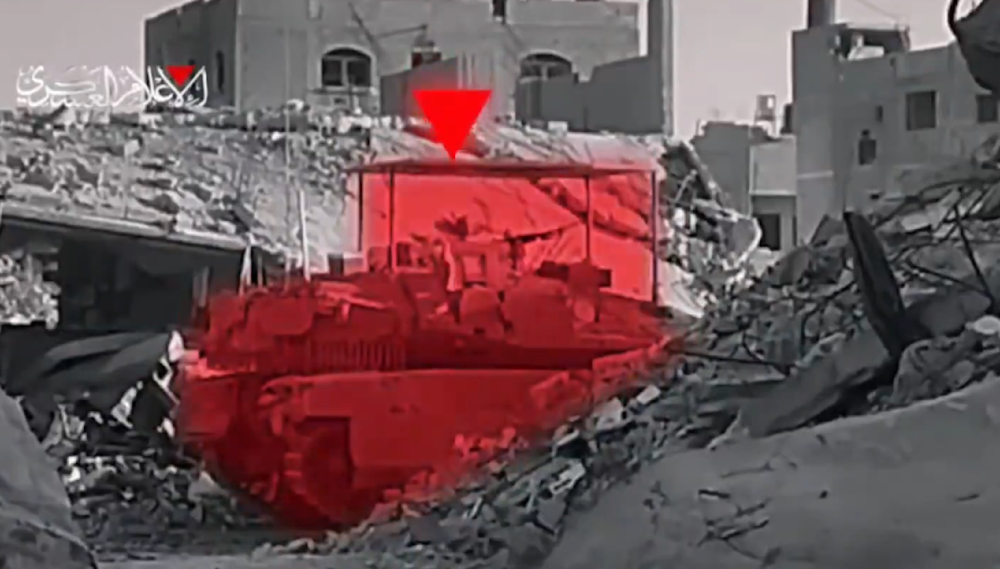Hamas' tactics in North Gaza make it hard to defeat: NYT
According to The New York Times, Hamas’ small-scale, hit-and-run approach has allowed it to continue inflicting damage on "Israel" while avoiding defeat.
-

The moments before the Palestinian resistance hit an Israeli tank carrying Israeli troops by an anti-tank missile in Jabalia. (Social media)
Despite the Israeli military claiming it has significantly weakened the Palestinian resistance movement, Hamas, the group remains undefeated, particularly in northern Gaza, The New York Times reported.
Despite the martyrdom of top commanders, Hamas continues to operate effectively as a guerrilla force.
The recent killing of Israeli Colonel Ehsan Daqsa by a planted explosive exemplifies Hamas' ability to endure nearly a year since the Israeli invasion last October and suggests it will continue to resist even after the recent death of its leader, Yahya Sinwar.
Hamas fighters are utilizing destroyed buildings and a vast underground tunnel network, which largely remains intact, to launch small-scale attacks and set up booby traps, planting roadside bombs, and firing grenades at Israeli forces before retreating underground.
Hamas’ small-scale, hit-and-run approach has allowed it to continue inflicting damage on "Israel" while avoiding defeat, according to NYT.
The group continues to inflict damage on "Israel" using a stockpile of explosives and small arms.
In the Jabalia refugee camp, one day after eliminating the commander of the 401st Armored Brigade, Colonel Ehsan Daqsa, and seriously wounding the commander of the Brigade's 52nd Battalion, Hamas executed yet another major ambush in the camp.
Currently, the town of Jabalia in the northern Gaza Strip is being subject to an Israeli campaign of ethnic cleansing, which the Israeli regime describes as the "Generals' Plan."
This is the third incursion by the IOF this year in the camp as Hamas continues to regroup.
Sinwar may be dead but Hamas lives on: Foreign Policy
According to Steven A. Cook, it has become a cliché to assert that "you cannot kill an idea."
Cook writes in Foreign Policy that although Palestinian martyr Yahya Sinwar was the mastermind of Operation Al-Aqsa Flood and "Israel" believes it achieved a great deal by murdering him,
He recounts the many various leaders of different Resistance movements in Lebanon and Palestine and how their assassinations helped build the "mythology of Israel’s security services." Despite this, Cook asserts that "Israel" still has not managed to defeat armed Resistance factions.
He details how Sayyed Hassan Nasrallah made Hezbollah one of the greatest Resistance movements in the region after the death of Sayyed Abbas al-Mousawi in 1992 and how subsequently, following the martyrdom of Sayyed Nasrallah and significant leaders within Hezbollah, it has still launched an unprecedented barrage of rockets at "Israel".
Sheikh Ahmad Yassin, the early leader of Hamas, similar to Sayyed Nasrallah, was also martyred in an airstrike. Cook notes that if his violent death didn't lead his successors to rethink their approach, why would Sinwar's killing have any different result?
Although some believe Sinwar's death could weaken Hamas, Cook emphasizes that resistance is a "critical component of identity," detailing how Sinwar preferred to meet his end from an Israeli tank shell rather than a natural cause, believing that his martyrdom would serve as motivation for further resistance.
"That Israel killed Sinwar seems like a major achievement today, but in time, others will rise—as they always have—to continue to resist," he concludes.

 3 Min Read
3 Min Read








